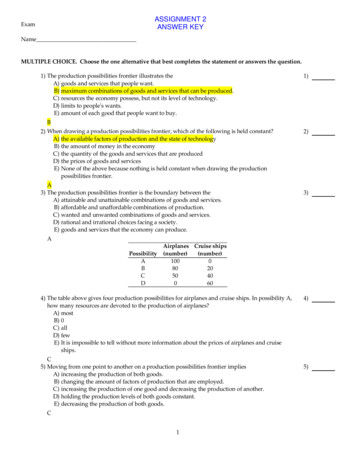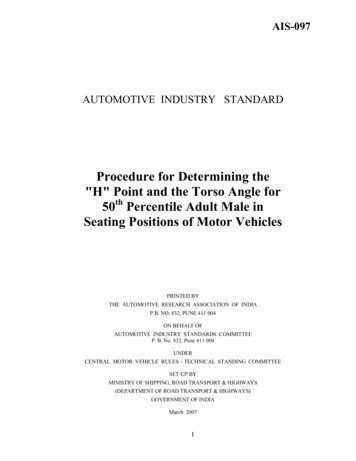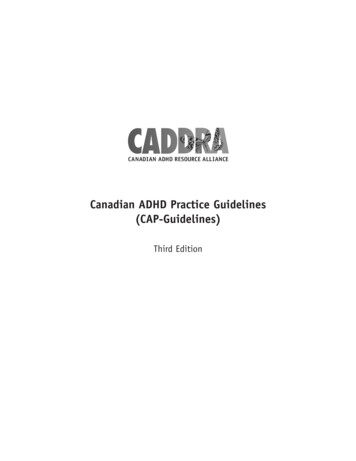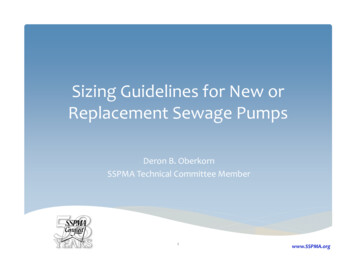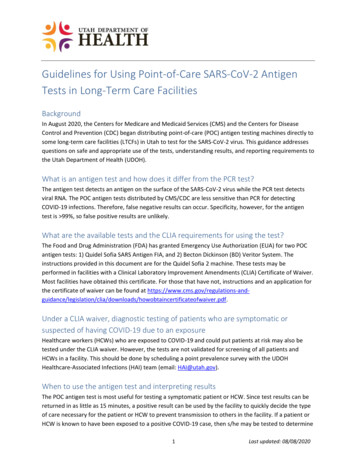
Transcription
Guidelines for Using Point-of-Care SARS-CoV-2 AntigenTests in Long-Term Care FacilitiesBackgroundIn August 2020, the Centers for Medicare and Medicaid Services (CMS) and the Centers for DiseaseControl and Prevention (CDC) began distributing point-of-care (POC) antigen testing machines directly tosome long-term care facilities (LTCFs) in Utah to test for the SARS-CoV-2 virus. This guidance addressesquestions on safe and appropriate use of the tests, understanding results, and reporting requirements tothe Utah Department of Health (UDOH).What is an antigen test and how does it differ from the PCR test?The antigen test detects an antigen on the surface of the SARS-CoV-2 virus while the PCR test detectsviral RNA. The POC antigen tests distributed by CMS/CDC are less sensitive than PCR for detectingCOVID-19 infections. Therefore, false negative results can occur. Specificity, however, for the antigentest is 99%, so false positive results are unlikely.What are the available tests and the CLIA requirements for using the test?The Food and Drug Administration (FDA) has granted Emergency Use Authorization (EUA) for two POCantigen tests: 1) Quidel Sofia SARS Antigen FIA, and 2) Becton Dickinson (BD) Veritor System. Theinstructions provided in this document are for the Quidel Sofia 2 machine. These tests may beperformed in facilities with a Clinical Laboratory Improvement Amendments (CLIA) Certificate of Waiver.Most facilities have obtained this certificate. For those that have not, instructions and an application forthe certificate of waiver can be found at pdf.Under a CLIA waiver, diagnostic testing of patients who are symptomatic orsuspected of having COVID-19 due to an exposureHealthcare workers (HCWs) who are exposed to COVID-19 and could put patients at risk may also betested under the CLIA waiver. However, the tests are not validated for screening of all patients andHCWs in a facility. This should be done by scheduling a point prevalence survey with the UDOHHealthcare-Associated Infections (HAI) team (email: HAI@utah.gov).When to use the antigen test and interpreting resultsThe POC antigen test is most useful for testing a symptomatic patient or HCW. Since test results can bereturned in as little as 15 minutes, a positive result can be used by the facility to quickly decide the typeof care necessary for the patient or HCW to prevent transmission to others in the facility. If a patient orHCW is known to have been exposed to a positive COVID-19 case, then s/he may be tested to determine1Last updated: 08/08/2020
if transmission occurred. However, false negatives may occur, so negative tests need to be followed upwith a standard PCR test. When there is concern of a possible outbreak in the facility, contact the UDOHHAI team (email: HAI@utah.gov) for assistance with further testing. Do not attempt to use the antigentest to screen all asymptomatic HCWs and patients in the facility since the test is not validated for thispurpose.How to report a positive result to the Utah Department of HealthAll tests performed for COVID-19 reportable to the UDOH within 24 hours of test . Please email notifications of new positive cases toedx@utah.gov. A UDOH person will work with the facility to assist with on-boarding for electronic casereporting. All test results (positive, negative, equivocal, indeterminate) for all test types (PCR, antigen,serology) are reportable. Test results must be reported within 24 hours of test finalization. Test results must be reported to UDOH for all persons who live in Utah or whose specimen wascollected by a Utah facility.How to collect a specimen safelyThe antigen test does not require a nasopharyngeal (NP) specimen, although this can be used. Thespecimen collection kit accompanying the test contains a nasal swab for the anterior nares or midturbinate collection. For the anterior nares and mid-turbinate collection, the HCW should be wearing, atminimum, a surgical mask, face shield, gown and gloves. A fit-tested N-95 or PAPR is not needed sincethis procedure should not result in the patient coughing or sneezing; however, if this equipment isavailable, it can be used for extra protection of the specimen collector. Insert the swab in both nares to increase sensitivity. Using the dry swab without transportmedia is the preferred method since transport media requires extra steps for test processingand may lower the sensitivity of the test due to dilution.NOTE: Assuming that most facilities will be conducting testing to obtain rapid results for theirresidents and HCWs, transport media should not be needed. If for some reason, transporting ofspecimens is necessary, specific transport media must be used and additional processing steps arerequired that are not addressed in this document. Insert the dry swab directly into the Reagent Tube which contains the Reagent Solution (seePreparing the reagent tube and specimen for testing).What is supplied in the Sophia-2 kit? Reagents and materials suppliedo Individually Packaged Test Cassettes (25): Monoclonal anti-SARS antibodieso Reagent Tubes (25): Lyophilized buffer with detergents and reducing agentso Reagent Solution (25): Ampoules with salt solutiono Sterile Nasal Swabs (25)o Small, Clear 120 µL Fixed Volume Pipettes2Last updated: 08/08/2020
ooo SARS Positive Control SwabNegative Control SwabQC Card (located on kit box)Materials not supplied (except for the timer or watch and Calibration Cassette, thesematerials are not needed as long as specimens are not transported)o Timer or watcho Vortexo 1.0-mL Calibrated Micropipette with Pipette Tipso Polyester Wound Swab or Nylon Flocked Nasopharyngeal Swabo Copan UTM or CDC VTMo Calibration CassetteQuality control proceduresPerform quality control procedures before beginning testing. Calibration check (should be performed every 30 days)o Perform the calibration check procedure every 30 days.o To check the calibration of Sofia 2, select “Run Calibration” on the Main Menu.o Following the prompts, insert the Calibration Cassette into Sofia 2 and close the drawer.Sofia 2 performs the calibration check automatically within 1 minute with no user inputrequired.o Sofia 2 indicates when the calibration check is completed. Selectto return to the“Run Test” screen.NOTE: If the calibration check does not pass, notify the on-site Supervisor or contact QuidelTechnical Support for assistance Monday through Friday from 7:00 a.m. to 5:00 p.m. PacificTime; PH: 800-874-1517 (U.S.); Fax: 858-455-4960; Email: customerservice@quidel.com(Customer Service) or technicalsupport@quidel.com (Technical Support); or contact your localdistributor. Built-in procedural controlso The Sofia SARS Antigen FIA contains a built-in procedural control feature. Each time atest is run on Sofia 2, the procedural control zone is scanned by the Sofia 2 and theresult is displayed on the screen.o A valid result obtained from the procedural control demonstrates that the test flowedcorrectly and the functional integrity of the Test Cassette was maintained.o The procedural control is interpreted by Sofia 2 after the Test Cassette has developedfor 15 minutes. If the test does not flow correctly, Sofia 2 will indicate the result isinvalid. Should this occur, review the procedure and repeat the test with a new patientsample and a new Test Cassette. External quality controlo Quidel recommends that Positive and Negative External Controls be run once for eachnew shipment of kits—provided that each different lot received in the shipment is tested.3Last updated: 08/08/2020
oooThe user must first select “Run QC” on the Main Menu of Sofia 2 and then, whenprompted, scan the QC Card (located on kit box). This card provides information specificto the kit lot, including lot number and expiration date.Select the desired mode (WALK AWAY or READ NOW), then run the External ControlSwabs.External Positive and Negative Control Swabs are supplied in the kit and should betested using the Swab Test Procedure provided in the package insert or in the QuickReference Instructions. The SARS Positive Control Swab contains SARS antigen. ThePositive Control Swab must be run first, followed by the Negative Control Swab. When the QC run is complete, each result will be displayed asoron Sofia2, for the Positive and the Negative Control. Do not perform patient tests or report patient test results if either of the QCtest results fail. Repeat the test or contact Quidel Technical Support beforetesting patient samples.Preparing the reagent tube and specimen for testingSwab test procedure for nasal swab Verify that the Sofia 2 is set to the desired mode: WALK AWAY or READ NOW.See “Using Sofia 2” for more information. Dispense all of the Reagent Solution into the Reagent Tube. Swirl the ReagentTube to dissolve its contents. Place the patient swab directly into the Reagent Tube. Roll the swab at least 3times while pressing the head against the bottom and side of the Reagent Tube. Leave the swab in the Reagent Tube for 1 minute. Roll the swab head against the inside of the Reagent Tube as you remove it.Dispose of the used swab in your biohazard waste. Fill the provided Small, Clear 120 µL Fixed Volume Pipette with the patientsample from the Reagent Tube.To fill the Fixed Volume Pipette with the patient sample:a) FIRMLY squeeze the top bulb.b) Still squeezing, place the Pipette Tip into the patient sample.c) With the Pipette Tip still in the patient sample, slowly releasepressure on the bulb to fill the Pipette. Firmly squeeze the top bulb to empty the contents of the Small, Clear 120 µLFixed Volume Pipette into the Test Cassette sample well. Extra liquid left overin the overflow bulb should be left behind.4Last updated: 08/08/2020
NOTE: The Fixed Volume Pipettes are designed to collect and dispense the correctamount of liquid sample. Discard the Pipette in your biohazard waste.Do not pour sample from the Reagent Tube. Use the provided Small, Clear 120 µL FixedVolume Pipette. Promptly proceed to the next section, “Using Sofia 2,” to complete the test.Using Sophia 2WALK AWAY Mode In WALK AWAY Mode, the user immediately inserts the Test Cassette into Sofia 2. The Sofia 2scans the Test Cassette periodically during the test development time. Positive and negative testresults will be displayed in 15 minutes.READ NOW ModeCritically Important: Allow the test to develop for the FULL 15 minutes BEFORE placing it into Sofia 2. The user must first place the Test Cassette onto the counter or bench top for 15 minutes(outside of Sofia 2) and manually time this development step. Then, insert the Test Cassette intoSofia 2. In READ NOW Mode, Sofia 2 will scan and display the test result within 1 minute. WARNING: Results must not be interpreted past 30 minutes after inoculation. Using the Sofia2 past this time may result in false results.Running the Test with Sofia 2 Input the User ID (1234) using the integrated barcode scanner ormanually enter the data using the on-screen keypad.NOTE: If you mistakenly scan the incorrect barcode, select the fieldagain to re-highlight it. Then simply rescan using the correct barcode,and the previous one will be overwritten with the correct barcode. Input the Patient ID (or Accession Number) using the barcodescanner or manually enter the data using the on-screen keypad. Verify that the correct development mode, WALK AWAY or READNOW, has been selected. Press and open the Sofia 2 drawer. Insert the prepared Test Cassette into the drawer of Sofia 2 and closethe drawer.5Last updated: 08/08/2020
Sofia 2 will start automatically and display the progress, as shownin the example below. In WALK AWAY Mode, the test results will bedisplayed on the screen in 15 minutes. In READ NOW Mode, thetest results will be displayed on the screen within 1 minute. See“Reading results on the Sofia 2.” Additional Precautionso NEVER open the foil pouch of the Test Cassette exposing it to the ambient environment untilthe Test Cassette is ready for immediate use.o To obtain accurate results, an opened and exposed Test Cassette should not be used insidea laminar flow hood or in a heavily ventilated area.o To obtain accurate results, do not use visually bloody or overly viscous samples.Reading results on the Sofia 2 When the test is complete, the results will be displayed on the Sofia 2 screen. Test lines, whichare fluorescent, cannot be seen with the naked eye.The Sofia 2 screen will display results for the procedural control as beingor, and willindividually provide a positive or negative result for SARS. If the procedural control is, retestwith a new patient sample and a new Test Cassette. If a printer is connected, the results can beprinted manually by selecting the print icon while the test results are displayed on the screen.Positive ResultsNegative ResultsInvalid ResultsNOTE: A positive result does notrule out coinfections with otherpathogens.NOTE: Negative results frompatients with symptom onsetbeyond 5 days should be treatedas presumptive and confirmedwith a molecular assay.Invalid Result: If the test isinvalid, a new test should beperformed with a new patientsample and a new Test Cassette.AcknowledgementMuch of the text for the detailed laboratory procedures was prepared by Dr. Bert Lopansri, Director,Infectious Disease Laboratory, Intermountain Healthcare. UDOH HAI Team appreciates his contribution.6Last updated: 08/08/2020
Aug 8, 2020





